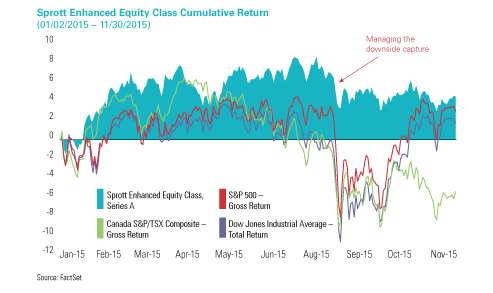When you look at the history of investing in Canada, what has been the primary catalyst for innovation and change? For the most part, it’s been the desire to address important investor needs – whether existing or evolving.
Canada’s first stock exchange was launched in the mid-1800s so people could participate in the growth of Canadian companies. In the 1930s, the first Canadian mutual fund allowed people without vast amounts of wealth to invest with others in a professionally managed pool of securities.
Today, the emerging trend in Canada relates to fulfilling the need for alternative investment strategies. Why? Think about the “new normal” economic environment following last decade’s global financial crisis. Also consider persistent geopolitical turmoil and its impact on financial markets. Increased volatility, higher risks, lower expected returns and declining fixed-income yields can lead to negative consequences for investors, especially among an aging demographic with the heightened need for capital preservation and a reliable income stream.
Understanding alternatives
Given today’s economic environment, it’s no wonder more and more individuals are looking at alternative investment strategies. Alternative strategies are sophisticated strategies that go beyond common investments like government bonds, large-capitalization Canadian equities and cash or cash equivalents. These traditional asset classes have formed the foundation of conservative portfolios for decades. Although traditional asset classes worked well for investors in the past, in today’s world having the majority of assets invested in limited segments of the market can lead to insufficiently diversified portfolios. When a portfolio is highly correlated, it lags in the ability to reduce risk and enhance returns.
“Portfolios that include alternative investments can help reduce a client’s downside risk and strengthen their overall performance,” says John Wilson, Chief Executive Officer, co-Chief Investment Officer and Senior Portfolio Manager at Sprott Asset Management, a company well known for its precious metals and resources mandates, and more recently for offering alternative investment strategies.
Many investors have shied away from alternative investments because of their perceived complexity and sophistication. Furthermore, in light of regulatory restrictions and hefty investment minimums, alternatives used to be the exclusive domain of ultra-high-net-worth individuals and institutional investors. Now, through retail funds, everyday Canadians can gain access to the benefits of alternative strategies that offer expert professional management.
“We believe actively managed strategies, particularly those in the uncorrelated alternatives space, can effectively improve portfolio diversification, provide a smoother ride for investors and offer greater potential for alpha generation,” says James Fox, President of Sprott Asset Management.
Finding the right portfolio strategy for your clients
As you recognize the need to introduce – or increase the allocation to – alternative investments in your clients’ portfolios, the next step is to address which products you select from the broad universe of alternatives. Each client’s circumstances are unique, which means the specific type and portfolio weighting of alternative strategies will also be unique. The following strategies represent examples of alternative investments.
Alternative core strategies, which are unique to Sprott, take an innovative approach to core asset classes such as large-cap Canadian equities and bonds. According to Sprott’s John Wilson, “Traditional fixed income used to provide a lower degree of volatility and a reasonable absolute return, but not in today’s environment. An alternative core strategy can satisfy these important investor needs and be a foundational component of a client’s portfolio.”
An alternative core equity strategy uses an options overlay to protect investors against negative market outcomes. This helps the fund withstand volatility, preserve capital, generate free cash flow and improve its risk-return profile. Having a sound defensive strategy with strictly imposed loss limits, a defined sell discipline and the ability to make tactical asset allocation shifts can help people stay invested through turbulent times, meaning they also participate in the superior long-term return potential of equities.
An alternative core fixed-income strategy can include an unconstrained mandate with a flexible, tactical approach. It aims to achieve stronger relative returns and lower volatility by proactively managing duration, interest rate, credit and liquidity risks.
Alternative income strategies have gained in prominence amid an environment of persistently low interest rates. Traditional fixed-income products, while still taking on high relative duration risk, no longer produce the level of income that they used to, leaving a void for yield-seeking investors. Alternative income strategies focus instead on lower duration risk while investing in the spectrum of fixed-income securities – from investment grade, high yield and floating rates to preferreds, convertibles and interest rate options – to generate higher levels of income.
Real asset strategies can invest in a diverse range of securities and assets, including precious metals, infrastructure, timber, agriculture, real estate equities and investment trusts, and more. Real assets tend to have a low correlation to traditional asset classes, meaning they can provide additional portfolio diversification with reduced volatility and enhanced return potential. As investing in real assets requires specialized knowledge and sector expertise, a professionally managed fund is a practical, liquid way to access the growth and income potential of real assets.
Give your clients a competitive advantage with alternatives
Increased market volatility and shrinking portfolio return expectations appear to be enduring trends that cannot be ignored. Your clients need portfolios that are optimized for efficiency, while also enhancing long-term growth potential, stability and downside protection. “With alternative investments,” says Sprott’s James Fox, “you can build better portfolios for your clients and, in the process, build a more successful practice.”
